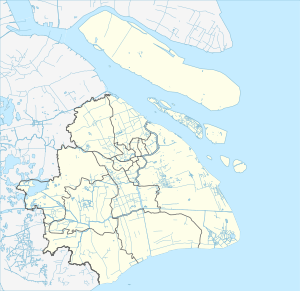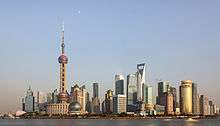Qibao
| Qibao 七宝镇 | |
|---|---|
| Town | |
|
Qibao Old Town | |
 Qibao Location in Shanghai | |
| Coordinates: 31°09′28″N 121°21′05″E / 31.15778°N 121.35139°ECoordinates: 31°09′28″N 121°21′05″E / 31.15778°N 121.35139°E | |
| Country | People's Republic of China |
| Municipality | Shanghai |
| District | Minhang |
| Village-level divisions |
54 residential communities 9 villages |
| Elevation | 7 m (23 ft) |
| Time zone | China Standard (UTC+8) |
| Postal code | 201101 |
| Area code(s) | 0021 |
| Website | www.qibao.gov.cn/ |
Qibao (simplified Chinese: 七宝镇; traditional Chinese: 七寶鎮; pinyin: Qībǎo Zhèn; literally: "Seven Treasures Town"; Shanghainese: tshih4pau2) is a town in Minhang District, Shanghai.[1] Its formation can be traced back to the Five Dynasties and Ten Kingdoms period, to the Northern Song Dynasty. The name comes from the local temple, "Qibao Temple".[2] Today, Qibao is a tourist attraction, in the area known as Qibao Old Town by the Puhui River with traditional Chinese architecture and a number of attractions, including museums and street food.[3]
Qibao is known for its speciality cuisine, hong shao rou ("red braised pork"), cooked using a combination of ginger, garlic, aromatic spices, chilli peppers, sugar, light and dark soy and sometimes rice wine. The town was also once the residence of the noted painter Zhang Chongren, a friend of the Belgian cartoonist Hergé, on whom the character Chang Chong-Chen from "The Adventures of Tintin" was based. Qibao is also known for crickets (with a "Cricket House") in the Qibao Old Town area.
Location
Located in the western suburbs of Shanghai, Qibao covers an area of 21.3 square kilometres (8.2 sq mi). It can be accessed by taking Shanghai Metro Line 9 to Qibao Station. As of 2011, it has 54 residential communities (居委会) and nine villages under its administration.[4]
References
- ↑ "Qibao Ancient Town". TravelChinaGuide. Retrieved 27 July 2009.
- ↑ Qibao Old Street: Look for the Saga of Shanghai. China: Shanghai Qibao Old Town Industrial Development Co. Ltd.
- ↑ Pitts, Christopher (April 2013). "Top Sights: Qibao". Pocket Shanghai (3rd ed.). Lonely Planet. pp. 102–103. ISBN 978-1-74179-963-7.
- ↑ 2011年统计用区划代码和城乡划分代码:七宝镇 (in Chinese). National Bureau of Statistics of the People's Republic of China. Retrieved 2013-01-03.
| Wikimedia Commons has media related to Qibao. |

